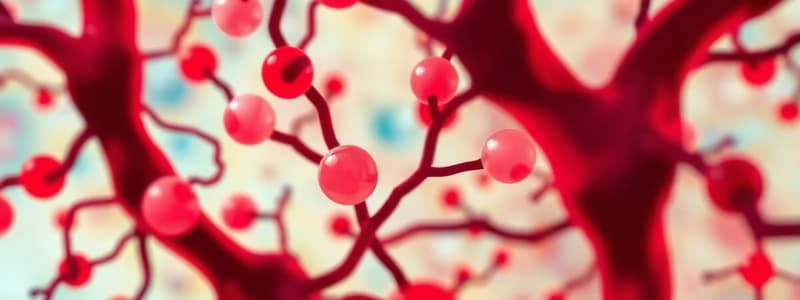Podcast
Questions and Answers
What does an adrenergic agonist stimulate?
What does an adrenergic agonist stimulate?
- Parasympathetic nervous system
- Somatic nervous system
- Sympathetic nervous system (correct)
- Central nervous system
What are the two neurotransmitters that adrenergic agonists mimic?
What are the two neurotransmitters that adrenergic agonists mimic?
Norepinephrine and epinephrine
What receptor sites do adrenergic agonists act on?
What receptor sites do adrenergic agonists act on?
- Heart, Bronchi, GI tract (correct)
- Heart, Lungs, Brain
- Muscles, Bones, Joints
- Liver, Kidneys, Pancreas
What effect does alpha 1 adrenergic activation have on the heart?
What effect does alpha 1 adrenergic activation have on the heart?
What effect does alpha 1 adrenergic activation have on blood vessels?
What effect does alpha 1 adrenergic activation have on blood vessels?
Alpha 1 adrenergic activation dilates pupils.
Alpha 1 adrenergic activation dilates pupils.
Alpha 1 adrenergic activation constricts the bladder.
Alpha 1 adrenergic activation constricts the bladder.
What effect does beta 1 adrenergic activation have on the heart?
What effect does beta 1 adrenergic activation have on the heart?
Beta 1 adrenergic activation decreases renin secretion.
Beta 1 adrenergic activation decreases renin secretion.
What effect does beta 2 adrenergic activation have on the lungs?
What effect does beta 2 adrenergic activation have on the lungs?
Beta 2 adrenergic activation causes vasodilation in skeletal muscles.
Beta 2 adrenergic activation causes vasodilation in skeletal muscles.
Beta 2 adrenergic activation relaxes the uterus.
Beta 2 adrenergic activation relaxes the uterus.
Which adrenergic agonist is nonselective?
Which adrenergic agonist is nonselective?
What are the three major effects of epinephrine on the sympathetic nervous system?
What are the three major effects of epinephrine on the sympathetic nervous system?
What is a common medical use for epinephrine?
What is a common medical use for epinephrine?
Which of the following is NOT a common side effect of epinephrine?
Which of the following is NOT a common side effect of epinephrine?
Which of these is a contraindication for epinephrine use?
Which of these is a contraindication for epinephrine use?
What is a common caution for epinephrine use?
What is a common caution for epinephrine use?
What drug interaction should be monitored with epinephrine?
What drug interaction should be monitored with epinephrine?
Which of these is NOT part of an assessment for a patient receiving adrenergic agonist drugs?
Which of these is NOT part of an assessment for a patient receiving adrenergic agonist drugs?
Which of these is NOT a nursing intervention for patients receiving adrenergic agonist drugs?
Which of these is NOT a nursing intervention for patients receiving adrenergic agonist drugs?
Which of these is NOT a teaching point for patients receiving adrenergic agonist drugs?
Which of these is NOT a teaching point for patients receiving adrenergic agonist drugs?
Epipen should be refrigerated.
Epipen should be refrigerated.
Epipen should be used at the first sign of a reaction.
Epipen should be used at the first sign of a reaction.
What is the proper injection site for Epipen?
What is the proper injection site for Epipen?
After administering Epipen, the injection site should be massaged.
After administering Epipen, the injection site should be massaged.
Which of these is NOT a factor to assess when evaluating a patient's response to adrenergic agonist drugs?
Which of these is NOT a factor to assess when evaluating a patient's response to adrenergic agonist drugs?
Flashcards
Adrenergic Agonists
Adrenergic Agonists
Drugs that mimic the effects of norepinephrine and epinephrine, stimulating the sympathetic nervous system, and acting on adrenergic receptor sites throughout the body.
Alpha 1 Receptors
Alpha 1 Receptors
Adrenergic receptors that, when stimulated by agonists, increase vasoconstriction, contracts the prostate and relaxes the bladder, and dilate pupils.
Beta 1 Receptors
Beta 1 Receptors
Adrenergic receptors that, when stimulated by agonists, increase heart rate and contractility, and renin secretion.
Beta 2 Receptors
Beta 2 Receptors
Signup and view all the flashcards
Epinephrine
Epinephrine
Signup and view all the flashcards
Epinephrine Uses
Epinephrine Uses
Signup and view all the flashcards
Adrenergic Agonist Side Effects
Adrenergic Agonist Side Effects
Signup and view all the flashcards
Adrenergic Agonist Contraindications
Adrenergic Agonist Contraindications
Signup and view all the flashcards
Adrenergic Agonist Interactions
Adrenergic Agonist Interactions
Signup and view all the flashcards
Epi-Pen Use
Epi-Pen Use
Signup and view all the flashcards
Study Notes
Adrenergic Agonists
- Adrenergic agonists stimulate the sympathetic nervous system
- Mimic the effects of norepinephrine and epinephrine
- Act on adrenergic receptor sites, including the heart, bronchi, GI tract, urinary bladder, and ciliary eye muscles
Function of Adrenergic Receptors (Alpha 1)
- Increases cardiac contractility and vasoconstriction
- Dilates pupils
- Relaxes the bladder
- Contracts the prostate
Function of Adrenergic Receptors (Beta 1)
- Increases cardiac contractility and heart rate
- Increases renin secretion and blood pressure
Function of Adrenergic Receptors (Beta 2)
- Decreases GI tone and motility
- Bronchodilation
- Increases blood flow in skeletal muscles
- Relaxes smooth muscles of the uterus
- Activates liver glycogenolysis, increasing blood sugar
Epinephrine - Adrenergic Agonist
- Nonselective agonist, stimulating alpha 1, beta 1, and beta 2 receptors
- Activates the sympathetic nervous system
- Alpha 1 increases blood pressure
- Beta 1 increases heart rate
- Beta 2 promotes bronchodilation
Epinephrine Uses
- Anaphylaxis, anaphylactic shock
- Bronchospasms, status asthmaticus
- Cardiogenic shock, cardiac arrest
Epinephrine Side Effects/Adverse Reactions
- GI disturbances
- Sweating, headache, insomnia, dizziness, agitation, anxiety
- Hyperglycemia
- Palpitations, cardiac dysrhythmia
- Tachycardia
- Hypertension
Epinephrine Contraindications
- Tachycardia
- Glaucoma
- Labor
Epinephrine Caution
- Hypertension
- Prostatic hypertrophy
- Diabetes mellitus
Epinephrine Interactions
- MAOIs and tricyclic antidepressants intensify and prolong the effect
- Beta blockers block the effect
- Digoxin increases the risk of dysrhythmia
- Epinephrine increases blood sugar levels (lab values)
Assessment
- Vital signs
- Medication/medical history
- Current symptoms
- Baseline glucose level
Nursing Interventions
- Monitor blood pressure, heart rate, and urine output
- Monitor IV site for infiltration
- Give IV push slowly (1 mg/minute) unless in cardiac arrest
- Monitor client on cardiac monitor when giving IV
- Monitor for side effects (report hypertension, irregular heart rate, tachycardia)
- Monitor blood glucose in diabetic clients
Teaching
- Report side effects (palpitations)
- Avoid drugs that increase blood pressure (e.g., cold medications, diet pills)
- Avoid adrenergic agonists when breastfeeding
- Nasal sprays should be used for 3-5 days only
- Take medication as prescribed
- Demonstrate use of inhaled medications or drops
Epi-Pen Teaching
- Inform provider if Epipen is used more than twice a week
- Keep Epipen with you at all times in a cool, dark place
- Use Epipen at first sign of reaction
- Inspect the Epipen contents for pink or brown particles and do not use if found
- Inject subcutaneously in the outer thigh and hold for 5-10 seconds
- Massage the injection site after administration
- Report any side effects
Evaluation
- Client's response to medication
- Improvement in symptoms?
- Any side effects/adverse reactions?
- Client understanding of medication and proper usage?
Studying That Suits You
Use AI to generate personalized quizzes and flashcards to suit your learning preferences.



